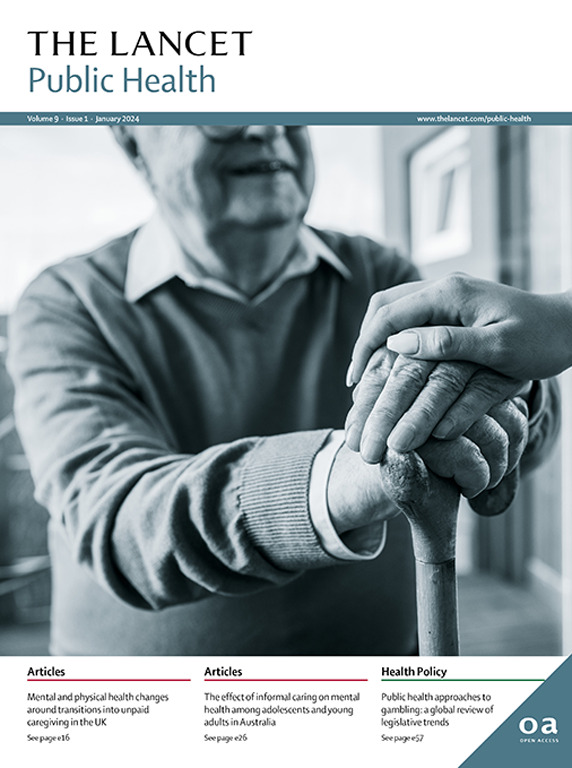Vaping among adults in England who have never regularly smoked: a population-based study, 2016–24
IF 25.4
1区 医学
Q1 PUBLIC, ENVIRONMENTAL & OCCUPATIONAL HEALTH
引用次数: 0
Abstract
Background
E-cigarettes are increasingly used by smokers and ex-smokers, often to support smoking cessation, but also among those who have never regularly smoked. The aim of our study is to estimate time trends in vaping prevalence among adults who have never regularly smoked and describe the profile of adult never-regular-smokers who vape.Methods
In this nationally representative, monthly cross-sectional survey in England, 153 073 participants (aged ≥18 years) were recruited from July, 2016, to April, 2024. 94 107 (61·5%) of the 153 073 participants had never regularly smoked. Logistic regression estimated associations between survey wave and current vaping, overall, and by sociodemographic characteristics and alcohol consumption.Findings
Vaping prevalence among never-regular-smokers was relatively stable up to 2021, at an average of 0·5% (95% CI 0·5–0·6) between July, 2016, and December, 2020; it then increased rapidly, reaching 3·5% (2·8–4·4) in April, 2024. This increase was largely driven by young adults (19·0% [13·9–25·4] among individuals aged 18 years) and those with higher alcohol consumption levels (22·1% [11·7–37·8%] among the heaviest drinkers). By contrast, trends among all adults (including current and former smokers) suggested the rise in vaping prevalence plateaued among all ages by early 2023. In 2023–24, 55·6% (48·2–62·8) of never-regular-smokers who vaped reported vaping daily; 81·7% (75·4–86·7) had been vaping for 6 months or more. The most used devices in 2023–24 were disposables (50·2% [42·9–57·5]) and the most commonly used e-liquids contained 20 mg/mL or more nicotine (44·6% [37·4–52·0]).Interpretation
The number of adults in England who vape but have never regularly smoked rose rapidly between 2021 and 2024, particularly in younger age groups and most of these individuals reported vaping regularly over a sustained period. The public health impacts of this finding will depend on what these people would otherwise be doing: it is likely that some might have smoked if vaping were not an available option (exposing them to more harm), whereas others might not have smoked or vaped.Funding
Cancer Research UK.2016-24年英格兰从未定期吸烟的成年人中的吸烟情况:一项基于人口的研究
背景 吸烟者和戒烟者越来越多地使用电子烟,通常是为了支持戒烟,但也有从不经常吸烟的人使用电子烟。我们的研究旨在估算从未定期吸烟的成年人中吸食电子烟普及率的时间趋势,并描述从未定期吸烟的成年人中吸食电子烟者的概况。方法在英格兰进行的这项具有全国代表性的月度横断面调查中,从2016年7月到2024年4月共招募了153073名参与者(年龄≥18岁)。153 073 名参与者中有 94 107 人(61-5%)从未定期吸烟。逻辑回归估算了总体调查波次与当前吸烟率之间的关系,并按社会人口特征和饮酒量进行了分类。研究结果从未定期吸烟者的吸烟率在2021年之前相对稳定,在2016年7月至2020年12月期间平均为0-5%(95% CI 0-5-0-6);随后迅速上升,在2024年4月达到3-5%(2-8-4-4)。这一增长主要是由年轻成人(18 岁人群中为 19-0% [13-9-25-4])和饮酒量较高的人群(饮酒量最大的人群中为 22-1% [11-7-37-8%])推动的。相比之下,所有成年人(包括现在和以前的吸烟者)的趋势表明,到 2023 年初,所有年龄段的吸烟率上升趋于平稳。2023-2024年,55-6%(48-2-62-8)从未吸食过烟草的吸烟者表示每天都吸食;81-7%(75-4-86-7)吸食烟草已有6个月或更长时间。2023年至2024年期间,使用最多的设备是一次性吸食器(50-2% [42-9-57-5]),最常用的电子液体含有20毫克/毫升或更多的尼古丁(44-6% [37-4-52-0])。这一发现对公共健康的影响将取决于这些人在其他情况下会做什么:如果不选择吸食电子烟,有些人可能会吸烟(使他们受到更多伤害),而其他人可能不会吸烟或吸食电子烟。
本文章由计算机程序翻译,如有差异,请以英文原文为准。
求助全文
约1分钟内获得全文
求助全文
来源期刊

Lancet Public Health
Medicine-Public Health, Environmental and Occupational Health
CiteScore
55.60
自引率
0.80%
发文量
305
审稿时长
8 weeks
期刊介绍:
The Lancet Public Health is committed to tackling the most pressing issues across all aspects of public health. We have a strong commitment to using science to improve health equity and social justice. In line with the values and vision of The Lancet, we take a broad and inclusive approach to public health and are interested in interdisciplinary research.
We publish a range of content types that can advance public health policies and outcomes. These include Articles, Review, Comment, and Correspondence. Learn more about the types of papers we publish.
 求助内容:
求助内容: 应助结果提醒方式:
应助结果提醒方式:


